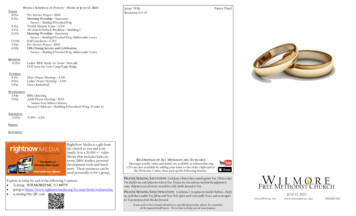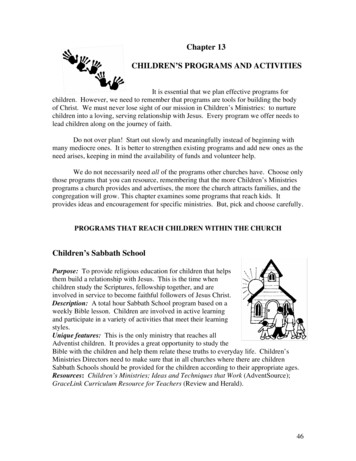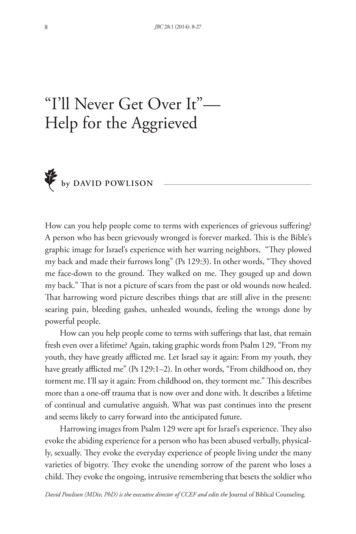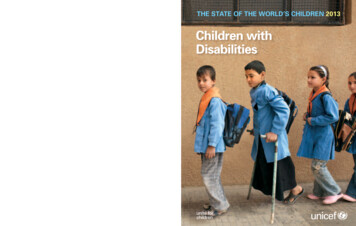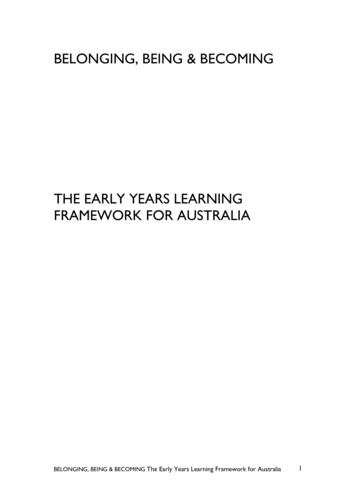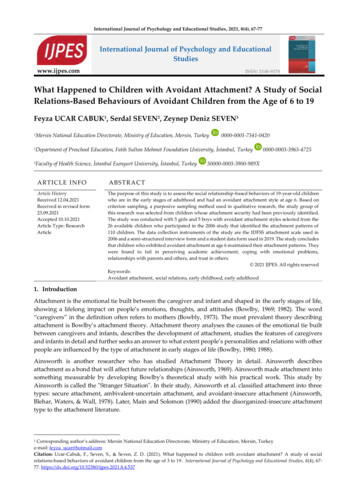
Transcription
International Journal of Psychology and Educational Studies, 2021, 8(4), 67-77International Journal of Psychology and EducationalStudieswww.ijpes.comISSN: 2148-9378What Happened to Children with Avoidant Attachment? A Study of SocialRelations-Based Behaviours of Avoidant Children from the Age of 6 to 19Feyza UCAR CABUK1, Serdal SEVEN2, Zeynep Deniz SEVEN31Mersin National Education Directorate, Ministry of Education, Mersin, Turkey0000-0001-7341-04202Department of Preschool Education, Fatih Sultan Mehmet Foundation University, İstanbul, Turkey3Faculty of Health Science, İstanbul Esenyurt University, İstanbul, Turkey0000-0003-3965-472530000-0003-3900-989XA RTICLE INFOA BST RA C TArticle HistoryReceived 12.04.2021Received in revised form23.09.2021Accepted 10.10.2021Article Type: ResearchArticleThe purpose of this study is to assess the social relationship-based behaviors of 19-year-old childrenwho are in the early stages of adulthood and had an avoidant attachment style at age 6. Based oncriterion sampling, a purposive sampling method used in qualitative research, the study group ofthis research was selected from children whose attachment security had been previously identified.The study was conducted with 5 girls and 5 boys with avoidant attachment styles selected from the26 available children who participated in the 2006 study that identified the attachment patterns of110 children. The data collection instruments of the study are the IDFSS attachment scale used in2006 and a semi-structured interview form and a student data form used in 2019. The study concludesthat children who exhibited avoidant attachment at age 6 maintained their attachment patterns. Theywere found to fail in perceiving academic achievement, coping with emotional problems,relationships with parents and others, and trust in others. 2021 IJPES. All rights reservedKeywords:Avoidant attachment, social relations, early childhood, early adulthood1. IntroductionAttachment is the emotional tie built between the caregiver and infant and shaped in the early stages of life,showing a lifelong impact on people’s emotions, thoughts, and attitudes (Bowlby, 1969; 1982). The word“caregivers” in the definition often refers to mothers (Bowbly, 1973). The most prevalent theory describingattachment is Bowlby’s attachment theory. Attachment theory analyses the causes of the emotional tie builtbetween caregivers and infants, describes the development of attachment, studies the features of caregiversand infants in detail and further seeks an answer to what extent people’s personalities and relations with otherpeople are influenced by the type of attachment in early stages of life (Bowlby, 1980; 1988).Ainsworth is another researcher who has studied Attachment Theory in detail. Ainsworth describesattachment as a bond that will affect future relationships (Ainsworth, 1969). Ainsworth made attachment intosomething measurable by developing Bowlby's theoretical study with his practical work. This study byAinsworth is called the "Stranger Situation". In their study, Ainsworth et al. classified attachment into threetypes: secure attachment, ambivalent-uncertain attachment, and avoidant-insecure attachment (Ainsworth,Blehar, Waters, & Wall, 1978). Later, Main and Solomon (1990) added the disorganized-insecure attachmenttype to the attachment literature.Corresponding author’s address: Mersin National Education Directorate, Ministry of Education, Mersin, Turkeye-mail: feyza ucar@hotmail.comCitation: Ucar-Cabuk, F., Seven, S., & Seven, Z. D. (2021). What happened to children with avoidant attachment? A study of socialrelations-based behaviors of avoidant children from the age of 3 to 19. International Journal of Psychology and Educational Studies, 8(4), 6777. https://dx.doi.org/10.52380/ijpes.2021.8.4.5371
International Journal of Psychology and Educational Studies, 2021, 8(4), 67-771.1. Attachment StylesAttachment is basically divided into two categories: secure and insecure attachment. Insecure attachment isclassified as anxious-ambivalent and anxious-avoidant (Ainsworth et al., 1978). Disorganized attachment islisted under insecure attachment (Main & Solomon, 1990).Secure attachment is the attachment style expected to occur when caregivers respond consistently to infants’needs with love and warmth. Securely attached infants/children develop a sense of confidence in themselvesand the environment as they know that their caregivers will be available and value them when they need.Anxious-Ambivalent attachment is the attachment style expected to develop when caregivers respondinconsistently to infants’ needs, such as warm, distressed, and neutral reactions in different cases or sometimessatisfy and sometimes fail to satisfy the infants. Children/infants who have this attachment pattern cannot besure that their caregivers will be available and comfort them because of their inconsistent behaviors. Therefore,they are insecure with their environment and their self-conception is often negative. Anxious-Avoidantattachment is expected to occur when caregivers are repeatedly cold, indifferent, and insensitive to infants’needs. Infants/children in this attachment type are sure that their caregivers will neither be available norcomfort them when they need. They believe that self-sufficiency is the best strategy. They are indifferent totheir environment. Their self-conception is often negative (Ainsworth et al., 1978; Hazan & Shaver, 1994;Simpson & Rholes, 1998; Barnet & Vondra, 1999). Disorganized attachment is often observed in children whoare abused or neglected by their caregivers. It might occur when caregivers suffer mental problems or drugaddiction. Infants/children in this attachment category are cold, depressive to their caregivers and lackconfidence and motivation (Main & Solomon, 1986; 1990).1.2. Effects of Attachment in Following AgesAccording to Bowlby (1980), the first attachment situation with other individuals begins in infancy and mightlast up to school age, adolescence, and adulthood. Only the attachment relationship with the caregiver mightadd cheer and persistence to one’s life. On the other hand, Ainsworth suggests that the attachment stylebetween infant and caregiver will be repeated in close relations in adulthood (Ainsworth, 1989).Various researchers have tested ainsworth and Bowlby’s different views on the life-long effects of attachment.Many subsequent studies have supported this view and concluded that attachment status overlaps with thefollowing life periods (Fraley, 2002; Moss, Cyr, Bureau, Tarabulsy, & Dubois-Comtois, 2005; Seven & Ogelman,2012; Waters, Hamilton, & Weinfield, 2000; Waters, Merrick, Treboux, Crowell, & Albersheim, 2000). Forexample, Waters et al (2000) assessed the attachment styles of a group of participants in infancy and 20 yearslater. Study results indicated that attachment styles were consistent.Attachment styles formed in early childhood are not only enduring, but continue to affect social, emotional,and behavioral characteristics of the individual (Lewis, 1990; Pearson et al., 1993). In particular, it influencesself-concept and perceptions of the environment through internal working models. Internal working models,clarified by attachment style and shaped by caregiver behavior, are the individual's perceptions of self andothers. Positive perceptions of self and others develop in secure attachment, whereas negative perceptionsdevelop in insecure attachment (Bretherton & Munholland, 1999). Clark (1996) indicates that adolescents withsecure attachments have fewer social problems and have more confidence in themselves and others. Shaver &Mikulincer (2002) reported that attachment styles have an impact on the quality of interpersonal relationshipsin adulthood.1.3. Current StudyThis study aims to evaluate the social relations-based behaviors of 19-year-old children who are accepted tobe in the initial adulthood period and had avoidant attachment style 13 years ago at the age of 6. In theattachment classification of Ainsworth et al. (1978), avoidant attachment is the attachment style where motherinfant interaction is the poorest and perception of self and others is negative. In the avoidant attachment style,infants believe that self-sufficiency is the best strategy, avoid asking caregivers for help in times of distressand keep indifferent to the existence and absence of their caregivers (Hazan & Shaver, 1994; Bretherton, 2003).Studies have revealed that individuals with avoidant attachment avoid close relations, are disturbed by socialattention, and have difficulty trusting others (Cooper, Shaver, & Collins, 1998; Shaver & Brennan, 1992).68
Feyza UÇAR ÇABUK, Serdal SEVEN & Zeynep Deniz SEVENAvoidant attachment is the most prevalent attachment style in Turkey according to studies conducted with 6year-old children (Seven, 2010; Seven & İlhan-Ildız, 2020). Longitudinal studies in Turkey and worldwide onchildren with avoidant attachment, a type of insecure attachment, in relation to their coping styles in socialproblems and emotional matters from early childhood to early adulthood are quite limited. Therefore, it isimportant that this study addresses the social relationships and emotional coping strategies of individuals inearly adulthood diagnosed with avoidant attachment at age 6. It is anticipated that the study of individualswith avoidant attachment styles longitudinally will contribute to the attachment literature. The purpose of thisstudy is to examine the social relationship-based behaviors of 19-year-old children who had an avoidantattachment style at age 6.2. Methodology2.1. Research ModelQualitative researches might be defined as a research type where qualitative data collection tools such asobservation, interview and document analysis are used and a qualitative process is followed to revealperceptions and cases in a natural setting with a realistic and holistic approach (Yıldırım & Şimşek, 2000). Anembedded multiple case study, one of the case studies types, was used in this study (Yin, 2003). This casestudy model was selected in order to reveal the social status of individuals who had an insecure avoidantattachment in 2006 at the age of 6.2.2. Study GroupBased on criterion sampling, a purposeful sampling method used in qualitative research, this research's studygroup was selected among children whose attachment security was previously identified. The study wascarried out with 5 girls and 5 boys with avoidant attachment selected among 26 children available whoparticipated in the study in 2006 where attachment patterns of 110 children were identified.The criteria used for identifying the research sample are given below. 1st Criteria: Taking the IDFSS in 2006 2nd Criteria: Having an avoidant attachment 3rd Criteria: No parent death or divorce10 of 12 individuals having these criteria were involved in the study.In order to identify social relationship patterns based on the process of mother-child bonding between theages of 6 and 19, the author conducted a study of children who participated in the IDFSS in 2006. As a resultof the study in the immediate area, likely participants were identified based on available participants.Participants were contacted and informed of the time and place of the interview. They were interviewed onthe agreed day and time. The demographic properties of children and families involved in the study arepresented in Table 1.Table 1. Demographic Properties of the Children and FamiliesGenderBoyGirlMothers’ Educational StatusPrimary schoolSecondary schoolHigh SchoolFamily StructureNuclear familyExtended familyEconomic .040.045140.050.010.069
International Journal of Psychology and Educational Studies, 2021, 8(4), 67-77According to the demographic properties of the children and families presented in Table 1, girls comprised50.0% (n 5) and boys comprised 50.0% (n 5) of the study group.The educational status data of the mothersshow that 30.0% of the mothers (n 3) were graduates of primary school and 60.0% (n 6) secondary school,while 10.0% of the mothers (n 1) were graduates of high school. In terms of family sturucture, 60.0% of thefamilies (n 6) were nuclear and 40.0% of the families (n 4) were extended family. In terms of the mother’seconomic status, 40.0% (n 4) had low economic status, 50.0% (n 5) middle economic status and 10.0% (n 1) ofthe mothers had high economic status.2.3. Data Collection ToolsThe research data collection tools are the IDFSS attachment scale used in 2006 and semi-structured interviewform and student data form used in 2019.2.3.1. IDFSSIt was developed by Cassidy (1988) to reveal mental representations of 6-year-old children on attachmentstatus by means of stories. There are six stories on the scale, and it takes nearly three minutes for the child tocomplete each story. Stories are scored on a 5-point scale. Stories that reflect the secure relationship with theattachment figure are scored 4 and 5 while stories reflecting hostile, negative relationship are scored 1 and 2and stories reflecting avoidant relationship are scored 3. Maximum scores in IDFSS is 30 while the minimumscore is 6. 30 define maximum attachment security and 6 defines maximum insecurity. IDFSS was adapted toTurkish by Seven (2006), who found its alpha coefficient 0.83 and split-half reliability 0.83 for scale scores.2.3.2. Interview FormSemi-structured interview form involves questions to identify self-perception styles of youngsters in socialsituations.2.3.3. Student Data FormThe authors developed student data form to learn demographic distributions of the children and families.2.4. Data AnalysisChildren were classified into attachment types with IDFSS in 2006. Descriptive-interpretive data analysis wascarried out in 2019. Data are reduced, put in a certain order, selected, and interpreted in this type of analysis.Interpretations are given a place on descriptions (Ekiz, 2007). In this study, data are analyzed; categories areestablished, graded, and revealed on graphs.2.5. Data Collection ProcedureIn the baseline of the study, 2006, a private room carrying suitable criteria for IDFSS was used forimplementing IDFSS. Data were collected in the second point, 2019 spring. Ethics board permission wasgranted before data collection for doing and voice-recording the interviews. Research for people to interviewwas carried out and probable participants were contacted by means of available participants. Each participantwas informed about the research before the interviews.70
Feyza UÇAR ÇABUK, Serdal SEVEN & Zeynep Deniz SEVEN3. Findings3.1. Perception of Academic Achievement* -1 negative achievement perception/ 0 Neutral/ 1 Positive Achievement perceptionFigure 1. Academic Achievement Perception of the Avoidant (B: Boys and G: Girls).None of the avoidant girls and boys finds themselves successful in academic terms. They see them under theirpotentials. It is observed that they lack confidence in academic achievement.Example statementsB2 I don’t find myself academically capable due to the incapability of others.B1 Am I successful? I am not sure.I can’t see strength in myself.3.2. Social Relations Success* -1 Unsuccessful / 0 Neutral- uncertain/ 1 SuccessfulFigure 2. Social Relations Success (B: Boys and G: Girls).Even when they reported being successful in social relationships, they gave detailed examples of poorrelationships and even confessed that they had failed. Transitions were observed from parents to friends andfrom friends to parents. This indicates that the status of their social relationships is shaped in the context oftheir relationships with the social environment. Boys were more likely to avoid relating to their relationshipswith their parents. Escape from mother to brother or father was observed. Intimacy problems in relationshipswere also mentioned.Example statements71
International Journal of Psychology and Educational Studies, 2021, 8(4), 67-77G3 I find myself successful, but we might have conflicts. I don’t know my position in social circle. I have problemswith mum when I am with friends and I have problems with friends when I get closer to mum.B4 I have excellent relations with people. Most of them love me. I am good at it.G2 I don’t trust others. My friends let me down. I am unsuccessful.B5 I don’t use social media. I stay far away from everyone in case they make fun of me.3.3. Relations with Parents* -1 Unsuccessful, avoiding talking about the relation/ 0 not sure, conditional/ 1 Successful/ feel closeFigure 3. Relations with Parents (B: Boys and G: Girls).One boy and one girl perceive their relationships with parents as positive, while other participants eitheravoid talking about their relationships or describe them as unsuccessful. Example statements:B4: Thanks God! it is fine with my parents. They love me and I love them (This boy reports that they did not havegod relations previously, but he overcame this problem by displaying unconditional respect to parents after hereceived religious education)B1. I cannot approach mum. My relations are poor. I am trying not to be a burden on my family.3.4. Coping with Emotional MattersAll participants find themselves incapable of coping with emotional matters. Another thing they have incommon is that they try to solve their emotional problems on their own.Example statementsG1 I am unsuccessful. I weep and fail to defend myself. I do not turn to others. I wait until it is over.B1 Unsuccessful. I cannot manage on my own. I need support but I cannot open to my family.B3 When I am upset, I go somewhere where I can be alone.72
Feyza UÇAR ÇABUK, Serdal SEVEN & Zeynep Deniz SEVEN3.5. Confidence in Others* -1 no confidence/ 0 conditional/ 1 trustsFigure 4. Confidence in others (B: Boys and G: Girls).Two of the participants trust only conditionally, while others are completely suspicious. They are likely tocome closer to the family if they feel distrust of others. Example statementG1 They have to be like me if I am to trust others (trust depends on them being like me)4. Discussion and ConclusionThe purpose of this study is to assess the social relationship-based behaviors of 19-year-old children who arein the first stage of adulthood and had an avoidant attachment style at age 6 13 years ago.None of the boys and girls with avoidant attachment styles who participated in the study succeededacademically. Okpycha and Courtneyb (2018) conclude in their longitudinal study that adolescents withavoidant attachment style do not attend their schools regularly, have poor grades, and perform poorly inschool. Kerns (2014) suggests that children who exhibit avoidant attachment characteristics may havedifficulty regulating emotions, which could affect anxiety and academic performance. There are numerousstudies in the literature that indicate a relationship between anxiety and academic achievement (Vatasari etal., 2010; Dan, Bar & Kurman, 2014; Lewis-Morrarty et al., 2015). Thus, it is believed that secure attachmentcreates a sense of security in children and has a positive impact on academic performance. On the other hand,it could be said that children who exhibit insecure attachment characteristics suffer from severe anxiety andtheir academic performance is negatively affected. The participants in the study see themselves as below theirmeans. Even though they claim to manage social relationships well, they detail examples of poor relationships.In a similar study, Uluç and Oekten (2009) conclude that children who have an avoidant attachment style areless popular with their peers than children who have a secure attachment style. According to Cassidy, Kirsh,Scolton, and Parke (1996), attachment style influences children's relationships with peers and provides afoundation for other relationships, while Granet and Maysel (2001) suggest that attachment style acts as amediating variable in peer relationships. In this case, it is expected that the social relationships of individualswith avoidant attachment will be negatively affected. There are also studies that suggest that children withavoidant attachment style are likely to suffer from behavioral and emotional problems in the future (Yalom,2014) and are less extroverted than children with secure attachment style (Kochanska & Kim, 2013) and thatthese factors affect their social relationships. There are also studies that suggest that children with avoidantattachment style are unfavorably affected in establishing social relationships in adulthood and theirrelationships are short and weak (Granet & Maysel, 2001; Moss, St-Laurent, Dubois-Comtois, & Cry, 2005;Lee,2008; Wiltz,2005).The authors observed that individuals avoid talking about relationships with peers, inaddition to fleeing from mother to brother, father. Intimacy problems in relationships were also mentioned.According to Bartholomew and Horowitz (1991), avoidant attachment is an attachment pattern in which theperson's perception of self is positive, but the perception of others is negative. People with avoidant attachmentstyle have high self-esteem but negative attitudes toward others and reject the need for close relationships.Therefore, these individuals avoid forming close relationships. Mikulincer, Shaver, and Solomon (2015)73
International Journal of Psychology and Educational Studies, 2021, 8(4), 67-77emphasize that attachment styles often remain stable over time, while they may change as a result of powerfulexperiences that influence people's beliefs about "the value of asking the attachment figure for help and thepossibility of accessing safety." Again, another study concludes that children who have an avoidantattachment style have high levels of anxiety in subsequent years and this situation leads to avoidance (ShamirEssakow, Ungerer, & Rapee, 2005).All the participants stated that they are not good at handling emotional situations. They feel that they are leftalone with their problems. Evirgen-Geniş and Goezuen-Kahraman (2018) investigated the correlation betweenattachment status and self-concept. They concluded that most of the participating children developedavoidant attachment. Moreover, they suggest that children's attachment status is positively correlated withtheir self-concept and social self-concept. Children with insecure attachment are far from self-sufficient andfeel unhappy. This perception is consistent with the finding that study participants with avoidant attachmentfeel alone. Stevens (2014) similarly examined whether individuals with different attachment styles exhibitdifferent abilities in defining and regulating emotions. He found that individuals with avoidant attachmenthad no awareness of defining emotions and showed less response to their emotions. This finding supportsMikulincer, Shaver, and Pereg's (2003) model that people deal with emotions in different ways depending ontheir attachment style. For example, individuals with avoidant attachment avoid reflecting on their emotions.Rholes, Simpson, Friedman (2006) conclude that couples with avoidant attachment style suffer from emotionalproblems and severe stress after birth and are dissatisfied with the experience of parenthood.All participants indicated that they were either conditionally or unconditionally distrustful of others. PaktunaKeskin (2014) in another study concludes that attachment is necessary for the child to gain trust in others,become aware of himself and the environment, and develop self-confidence. In a similar study, Ozturk (2017)concludes that mother-father attachment style significantly predicts self-confidence. In a longitudinal study,Simpson (1990) analyzed the effects of secure, anxious, and avoidant attachment styles on relationships andconcluded that individuals with avoidant attachment have less confidence and satisfaction in theirrelationships than individuals with secure attachment. According to attachment theory, the attachment styledeveloped in early childhood forms the basis for close friendships, personality, socio-emotional characteristics,and relationship development in subsequent life stages (Chow, 2008; Nathanael & Mark, 2018; Suemer, 2006;Rholes, Simpson & Friedman, 2006; Thompson, Grace & Cohen, 2002; Waters, Hamilton and Weinfield, 2000).This study supports the literature. It concludes that children who had avoidant attachment at age 6 maintainedtheir attachment patterns and therefore failed in this area: Perception of academic achievement, coping withemotional problems, relationships with parents and others, and trust in others.This study demonstrates the importance of identifying preschool children's attachment status. There are risksif preschool children with avoidant attachment status are not treated. The study also shows that the IDFSS,introduced in 2006, provides accurate results about children's security patterns. It is believed that theconclusions of the study will contribute to theoretical knowledge and become a reference for researchers. Inthis study, which assesses the social relationship-based behaviors of 19-year-old children with avoidantattachment patterns in childhood, an expansion of the study group and the use of other measurementinstruments could be recommended.Considering that attachment is a two-way process and there is often a correlation between the parents and thechild's attachment style, it might be advisable to include the parents and other community members who playa role in the child's life rather than focusing only on the child. An investigation into the causes of avoidantattachment in the Turkish community might also be recommended.5.ReferencesAinsworth, M. D. S. (1969). Object relations, dependency and attachment: A theoretical review of the ınfantmother relationship. Child Development, 40(4), 969-1025.Ainsworth, M. D. S. (1989). Attachments beyond716. https://doi.org/10.1037/0003-066X.44.4.709 .İnfancy.American Psychologist,44(4),709-Ainsworth, M. D. S., Blehar, M. C., Waters, E., & Wall, S. (1978). Patterns of attachment: A psychological study ofthe strange situation. Psychology: New York.74
Feyza UÇAR ÇABUK, Serdal SEVEN & Zeynep Deniz SEVENBarnett, D., & Vondra, J. I. (1999). Atypical patterns of early attachment: Theory, research, and currentdirections. Monographs of the Society for Research in Child Development, 64 (3),1-24.Bartholomew, K., & Horowitz, L. M. (1991). Attachment styles among young adults: A test of a four-categorymodel. Journal of Personality and Social Psychology, 61(2), 226-241. https://doi.org/10.1037/00223514.61.2.226Bowlby, J. (1973). Separation Anxiety and Anger, Attachmentand Loss. The Tavistock Institute of Human Relations,Volume II, United States of America.Bowlby, J. (1982). Attachment and loss: Sadness and depression. Marriage and Family, 44(1), 248-250.https://doi.org/10.2307/351282.Bowlby, J. (1988). A secure base:parent-child attachment and healthy human development (118-125), Perseus BooksGroup.Bowlby, J. (1980). Attachment and loss, loss sadness and depression (Volume III). Perseus Books Group.Bowlby, J. (1969). Attachment and loss, (Volume I). Basic Books, New York.Bretherton, I. (2003). Mary Ainsworth: Insightful observer and courageous theoretician. G. A. Kimble and M.Wertheimer (Ed.), Portraits of Pioneers in Psychology 5, (1-10), Hillsdale, NJ: Erlbaum.Bretherton, I. & Munholland, K.A. (1999). Internal working models in attachment relationships. J. Cassidy, andP. R. Shaver (Ed.), Handbook of attachment, second edition: Theory, research, and clinical applications (pp. 102122). New York: Guilford.Cassidy, J. (1988). Child-mother attachment and the self in six-year-olds. Child Development, 59(1), 121–134.https://doi.org/10.2307/1130394.Cassidy, J., Kirsh, S. J., Scolton, K. L., & Parke, R. D. (1996). Attachment and representations of peerrelationships. Developmental Psychology, 32(5), 892–904. https://doi.org/10.1037/0012-1649.32.5.892.Chow, K., & Healey, M. (2008). Place attachment and place identity: First-year undergraduates making thetransition from home to university. Journal of Environmental Psychology, 28(4), 1.Clark, S. T. (1996). Working models of attachment: ımplications for explanation, emotion, and behavior. Journalof Personality and Social Psychology, 71(4), 810-832.Cooper, M. L., Shaver, P. R., & Collins, N. L. (1998). Attachment styles, emotion regulation, and adjustment inadolescence. Journal of Personality and Social Psychology, 74(5), 1380-1397. https://doi.org/10.1037/00223514.74.5.1380.Dan, O., Bar Ilan, O., & Kurman, J. (2014). Attachment, self-esteem and test anxiety in adolescence and earlyadulthood. Educational Psychology, 34(6), 659–673. https://doi.org/10.1080/01443410.2013.814191.Ekiz, D. (2007). Investigation of pre-service teachers' views on educational philosophy movements in terms ofdifferent programs. Journal of Ondokuz Mayıs University Faculty of Education, 24, 1-12.Evirgen, G. N., & Gözün-Kahraman, Ö. (2018). Investigation of the relationship between attachment and selfperception in preschool children. Hitit University Journal of Social Sciences Institute, 11(3), 2446-2454. doi:10.17218/hititsosbil.417456.Fraley, R. C. (2002). A attachment stability from ınfancy to adulthood: Meta-analysis and dynamic 7957PSPR0602 03.Granot, D. & Mayseles, O. (2001). Attachment security and adjustment to school in middle childhood.International Journal of Behavioral Development, 25, 530-541. Doi: 10.1080/01650250042000366.Hazan, C. & Shaver, P. R. (1994). Attachment as an organizational framework forresearch on closerelationships. Psychological Inquiry, 5 (1), 1-22.75
International Journal of Psychology and Educational Studies, 2021, 8(4), 67-77Kerns, K.A. & Brumariu, L.E. (2014). Is ınsecure parent–child attachment a risk factor for the development ofanxietyinchildh
Insecure attachment is classified as anxious-ambivalent and anxious-avoidant (Ainsworth et al., 1978). Disorganized attachment is listed under insecure attachment (Main & Solomon, 1990). Secure attachment is the attachment style expected to occur when caregivers respond consistently to infants' needs with love and warmth.
